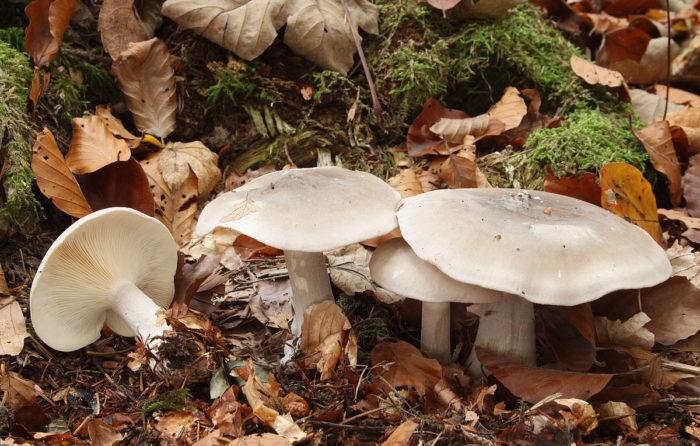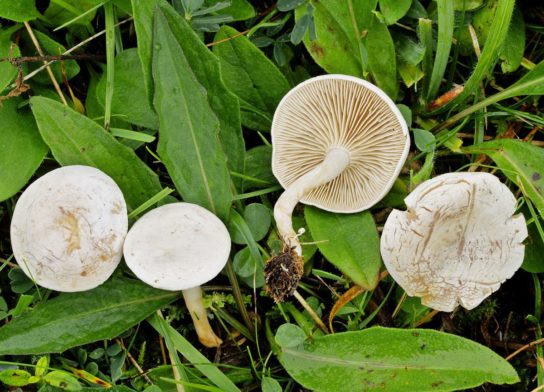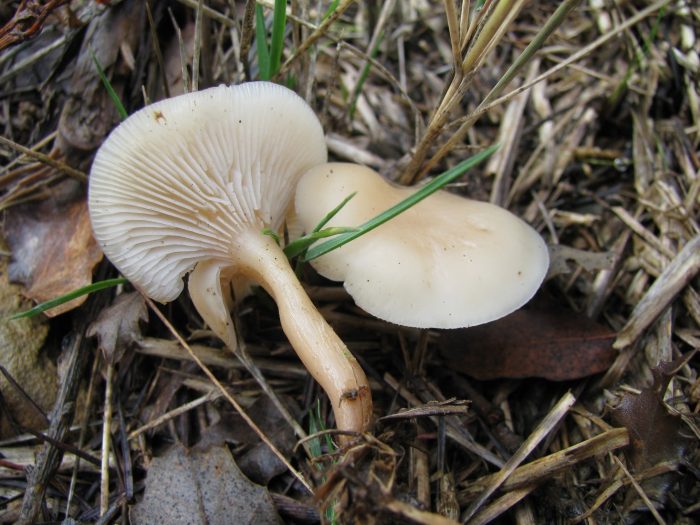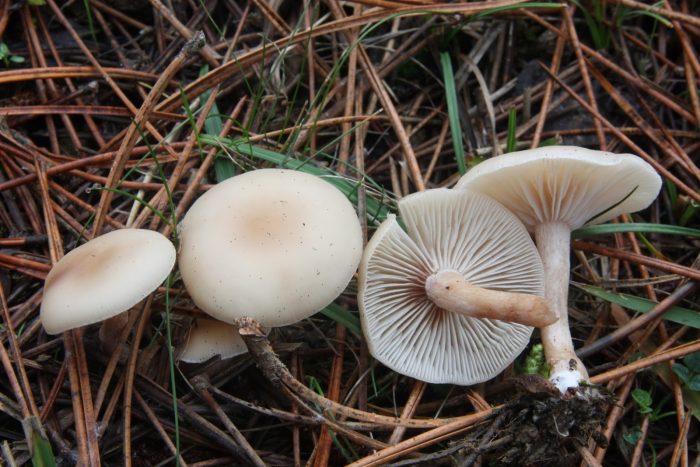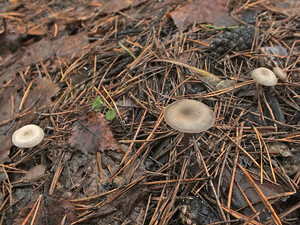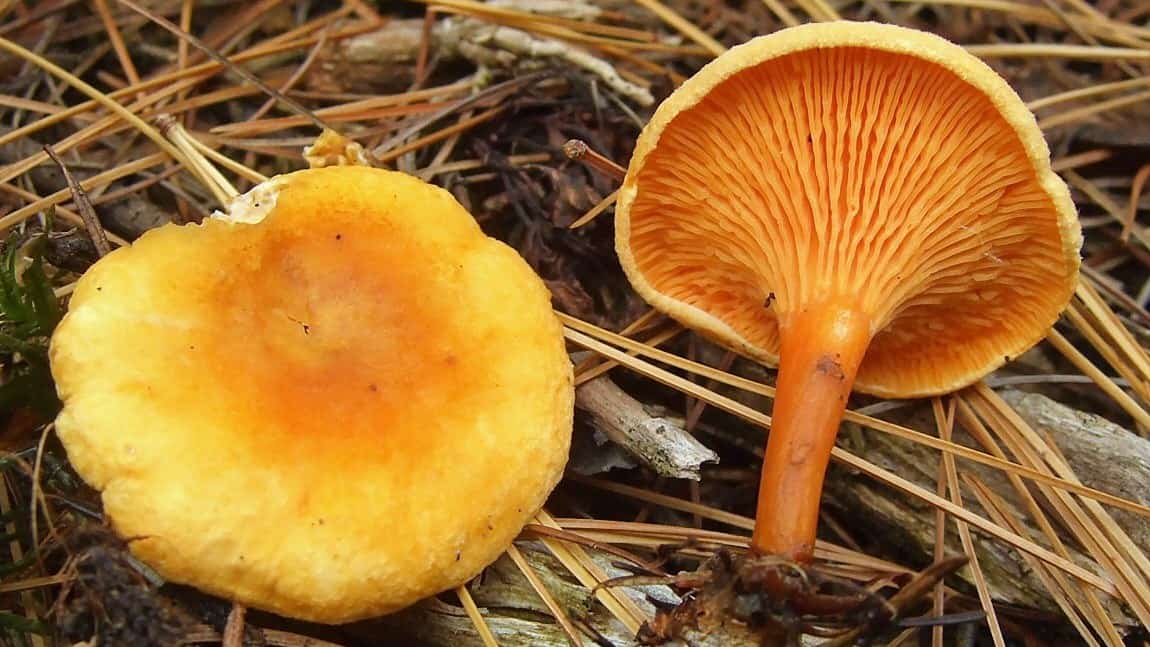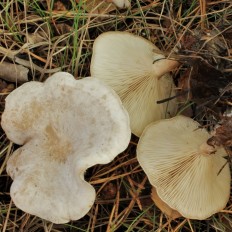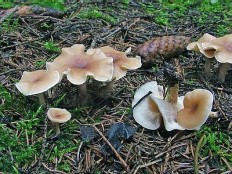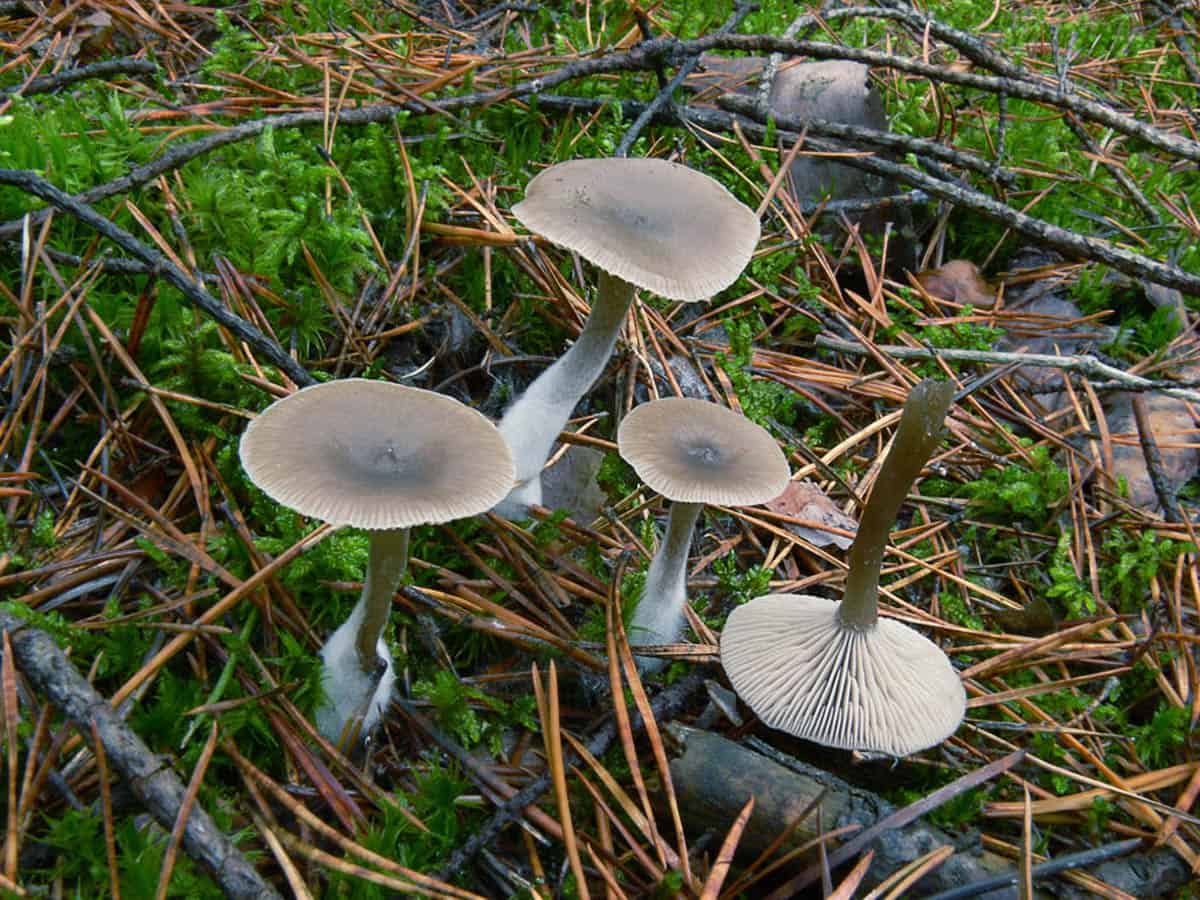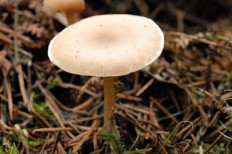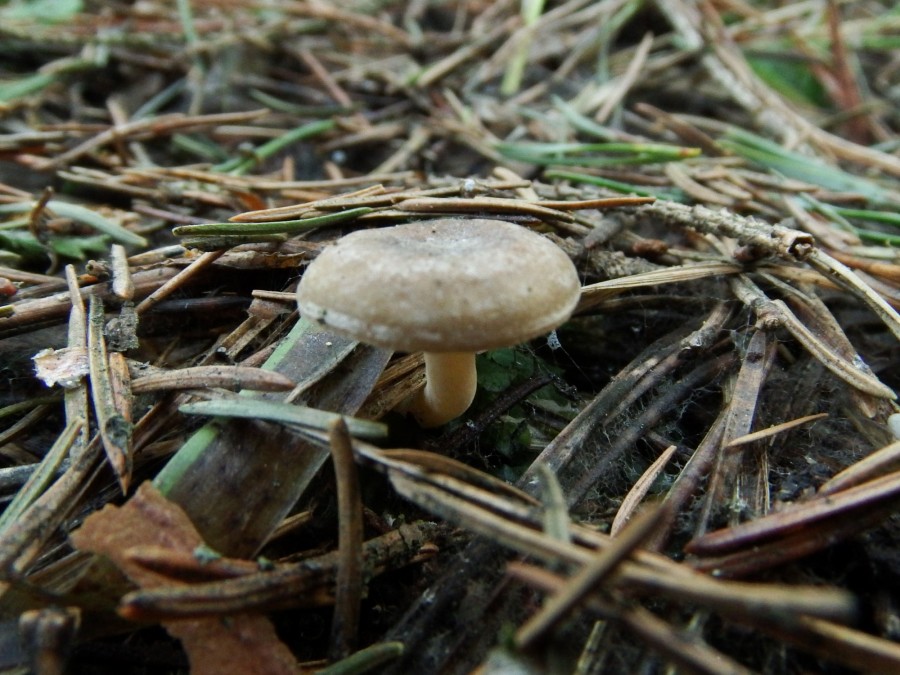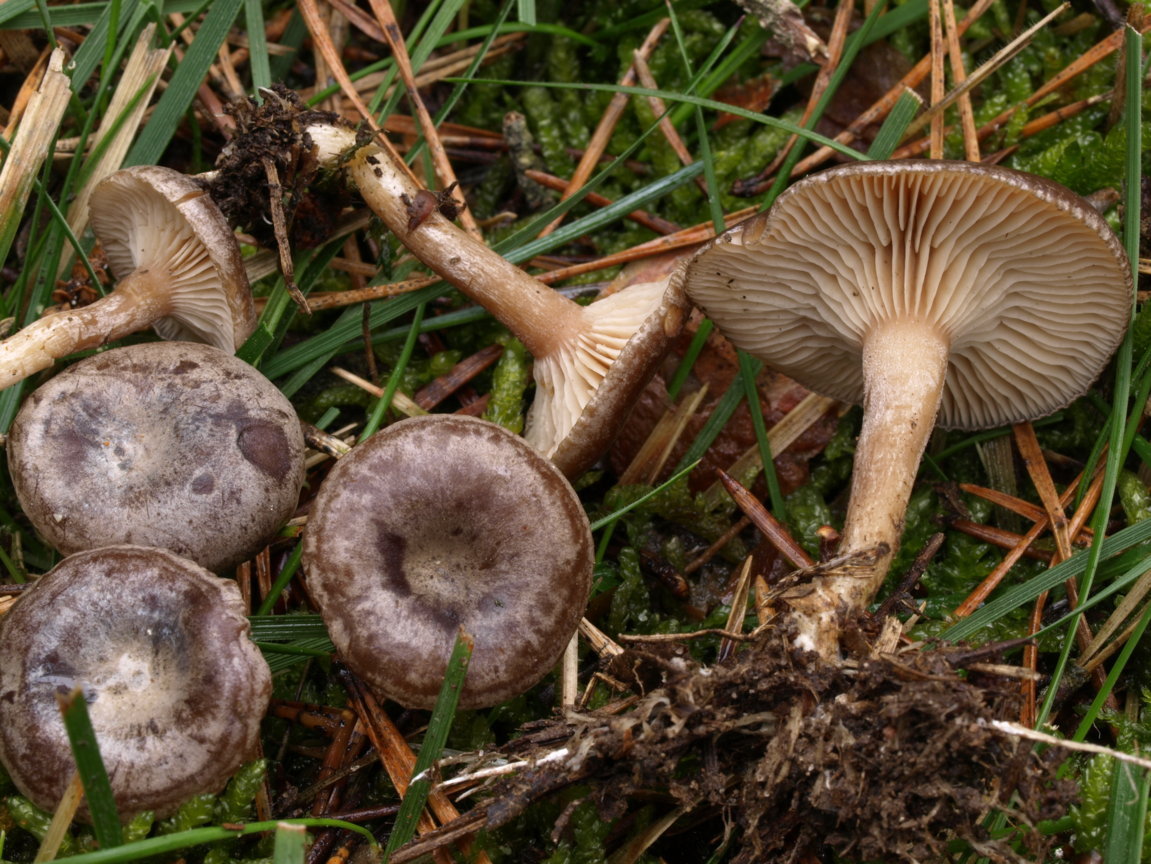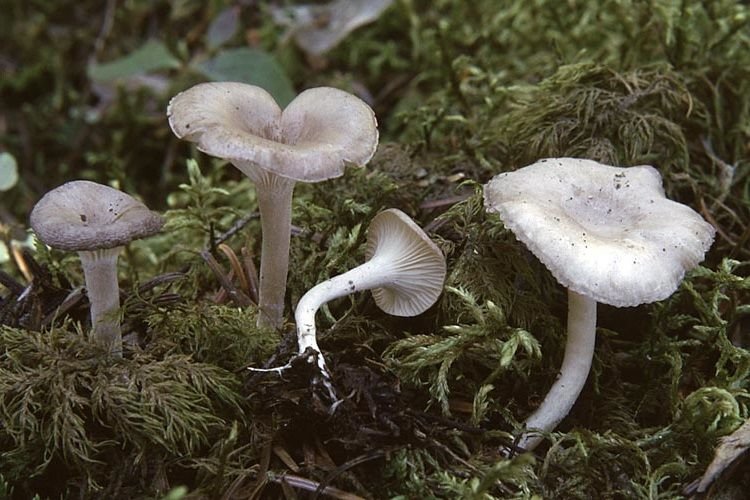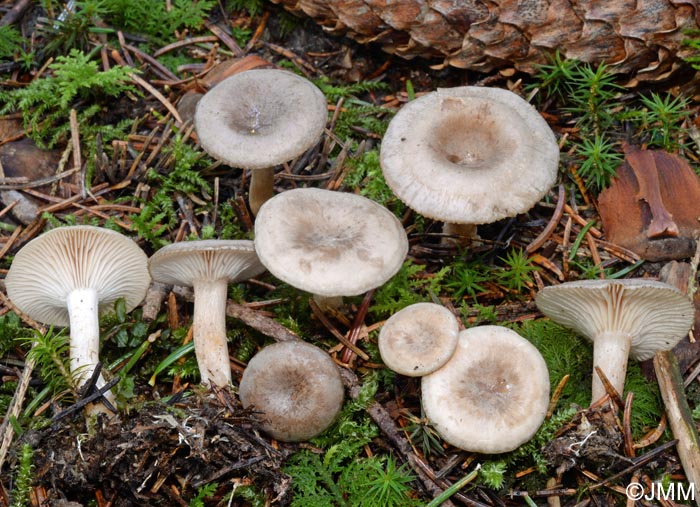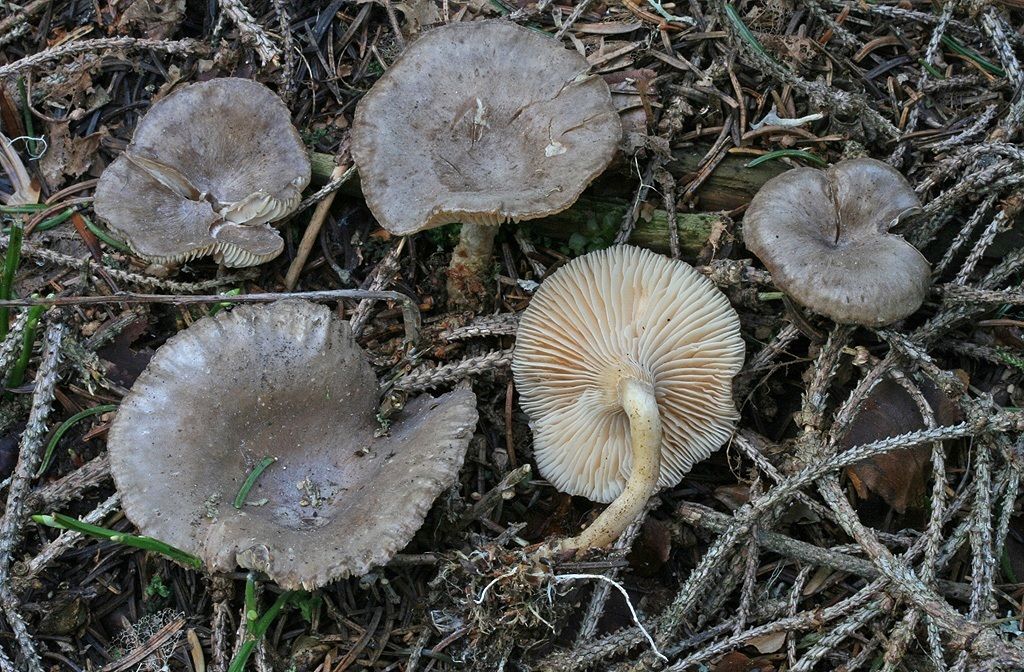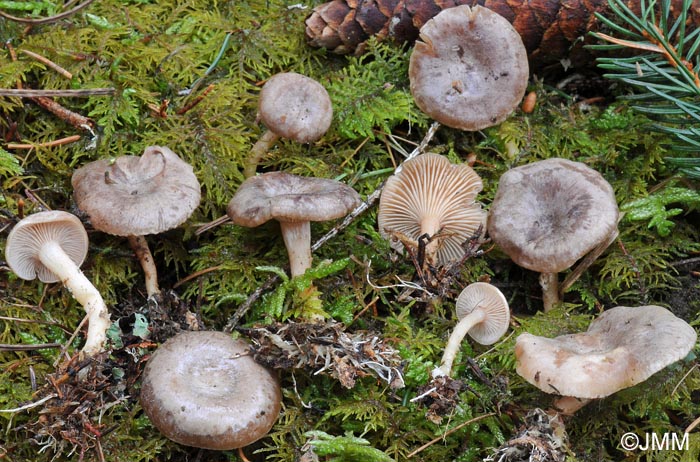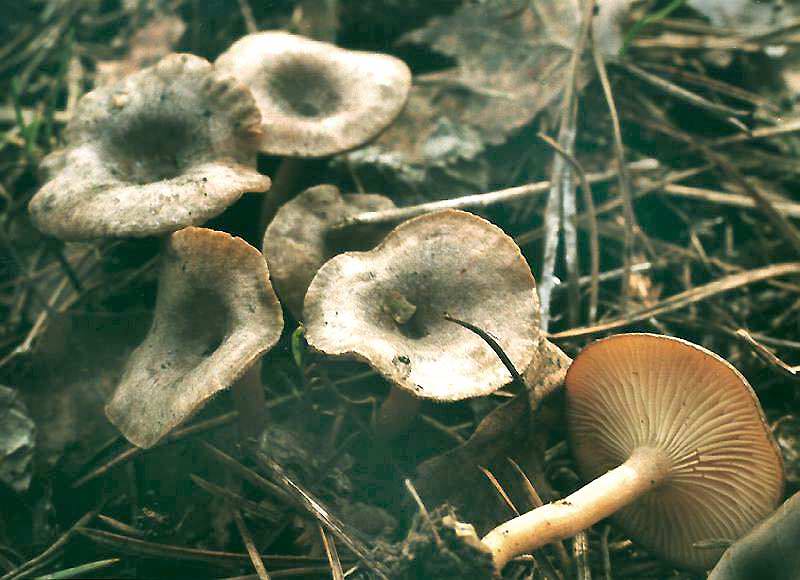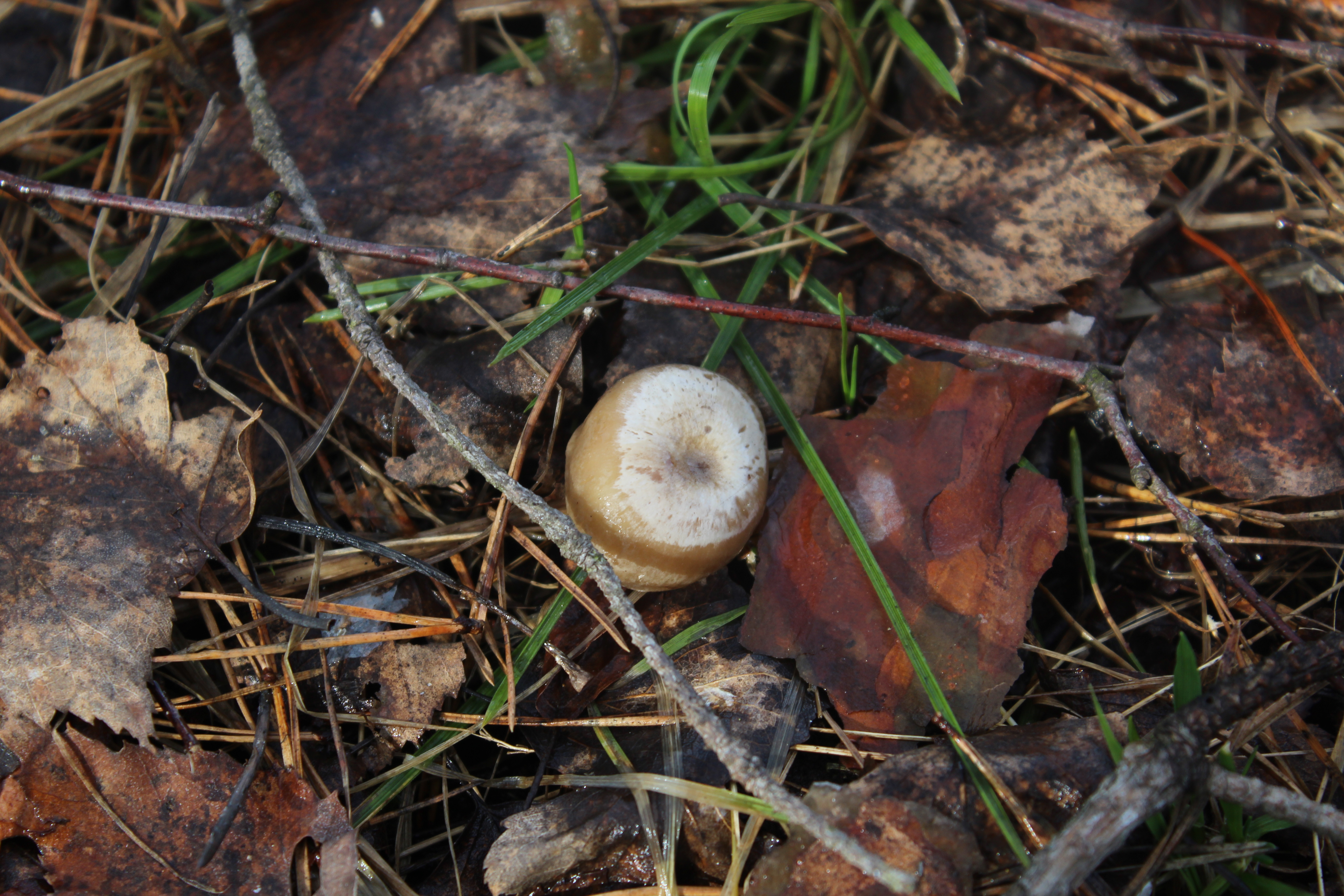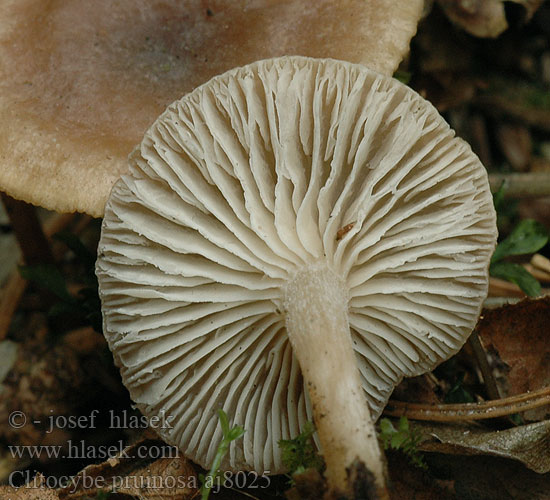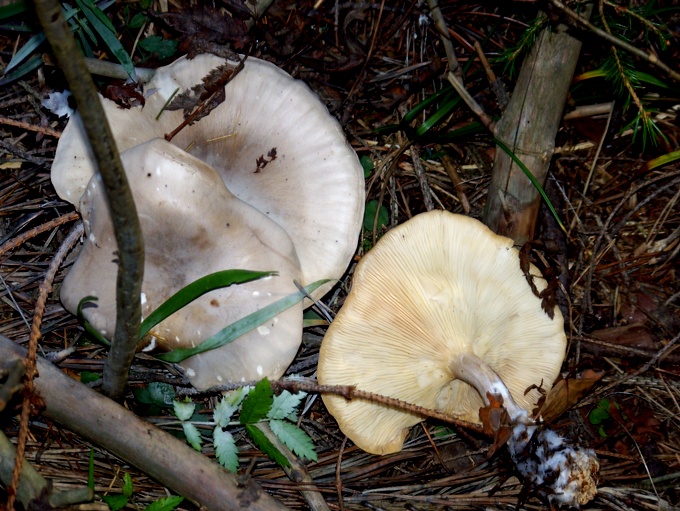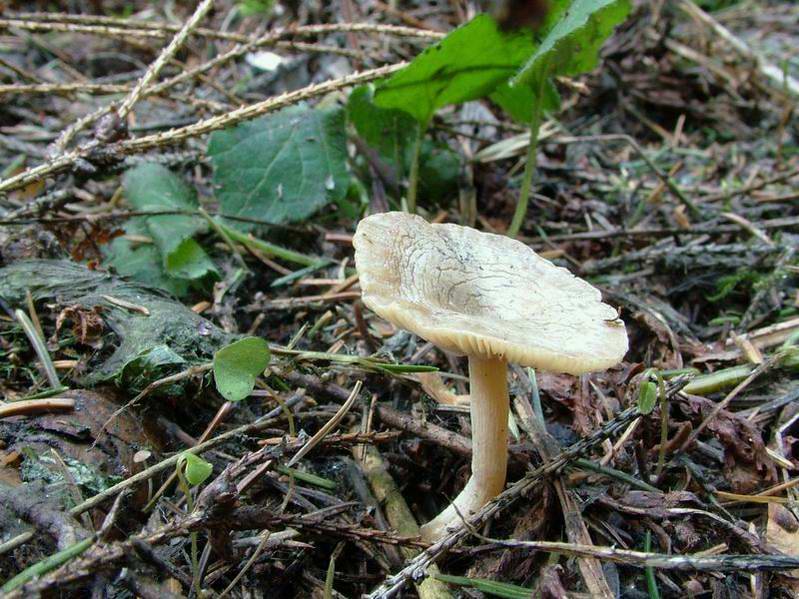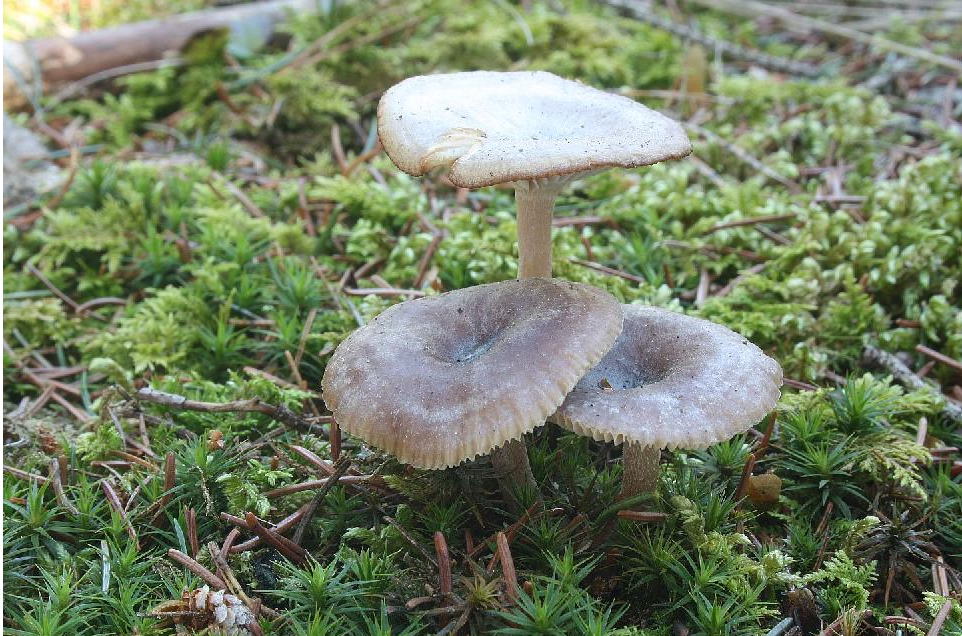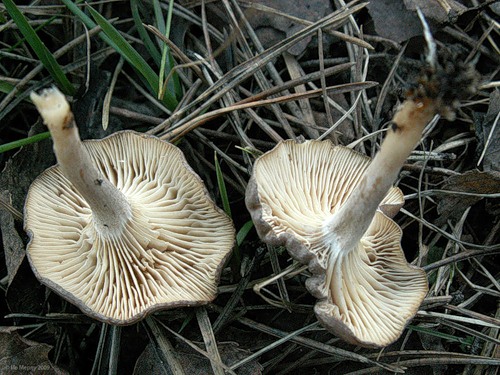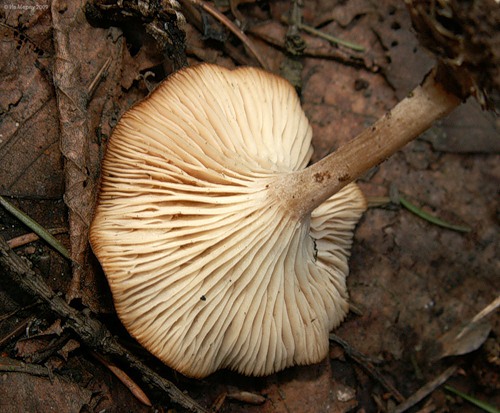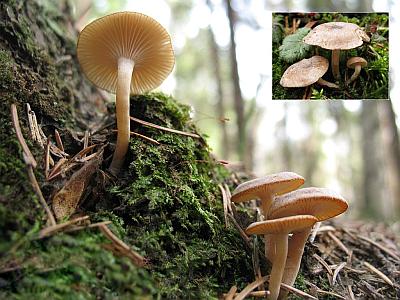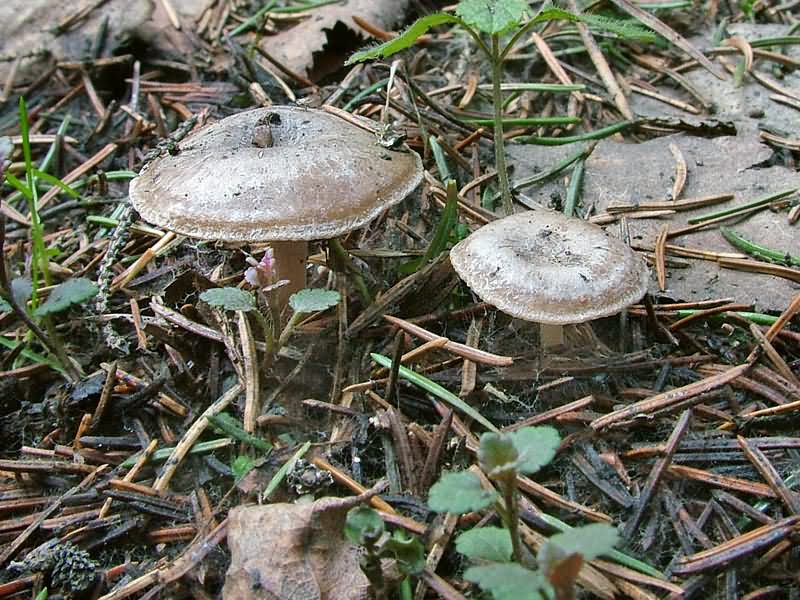Red-brown talker (Paralepista flaccida)
Synonyms:
- Red & brown talker
- Clitocybe flaccida
- Omphalia flaccida
- Lepista flaccida
- Clitocybe infundibuliformis sensu auct.
- Clitocybe inversa
- Omphalia inversa
- Lepista inversa
- Clitocybe gilva var. guttatomarmorata
- Clitocybe gilva var. tianschanica
Description
Hat with a diameter of 3-11 cm (sometimes up to 14 cm); initially convex with the edges tucked inward, with age it straightens out to a flat or even takes the form of a shallow funnel or bowl; its surface is dry, almost smooth, matte, orange-brown or brick-colored; hygrophane (turns pale when dry). The edge of the cap is often wavy, with pronounced depressions such as the spout of a jug, which distinguishes this species from the similar funnel-shaped talker (Clitocybe gibba). There is evidence that sometimes in inverted talkers, which appear already very late in autumn, the hat remains convex, without forming the usual depression in the center.
The plates are descending, narrow, rather frequent, at first almost white, later pinkish-beige or pale orange, with age they become dark orange or pink-brown.
Leg 3-10 cm in height and up to 1.5 cm in diameter, more or less cylindrical, dry, finely pubescent; painted to match the cap, only slightly lighter; pubescent of whitish mycelium at the base.
The pulp is thin (in the cap), whitish, with a sweetish odor, which is sometimes compared to the smell of frozen orange juice or bergamot, without a pronounced taste.
Whitish to off-white spore mark Spores 4-5 x 3.5-4 μm, practically spherical to broadly elliptical, finely warty, non-amyloid. Cystyds are absent. Buckled hyphae.
Chemical reactions
KOH paints the surface of the cap yellow.
Ecology and distribution
Saprophyte, grows scattered or in close groups on a coniferous litter, often at the foot of anthills, sometimes on wet sawdust and wood chips. More often found in coniferous and mixed forests, sometimes it grows on humus-rich soils, where it forms spectacular "witch rings". A common species in the Northern Hemisphere, common in North America, mainland Europe and Great Britain. The period of active growth is autumn, until the onset of cold weather, however, in some places it can shift to winter (for example, the coast of California), or continue - in mild climates - until January (for example, in Great Britain and Ireland).
What can be confused with an inverted talker
The funnel-shaped talker (Clitocybe gibba) found in the same biotopes is distinguished by a paler coloration, the absence of a wavy edge, and significantly larger, elongated white spores. In addition, it has a much thicker flesh in the cap. The brown-yellow bell (Paralepista gilva) has a lighter, creamy yellow or brownish-yellow hue, and the cap shows round watery spots (in youth) or dark rusty brown specks (in more mature specimens).
The much larger Lepista multiformis is found in open grassy areas (meadows, roadsides, parks and lawns), and has been recorded in Europe (rather rare).
Edibility
According to some sources, the Ginger-Brown Talker is not poisonous, but its nutritional quality leaves much to be desired, and there is little point in collecting it.
According to others, it is poisonous (contains muscarinic toxins).
Video about the mushroom Govorushka red & brown:
Symptoms of poisoning by the Voskovataya Speaker
In the case of muscarine poisoning, the following sequence of symptoms is observed:
- Within half an hour to six hours after taking the mushrooms, there is a sharp pain in the abdomen, followed by diarrhea and vomiting.
- A person begins to sweat profusely, salivation increases unnaturally.
- There is severe shortness of breath, the release of phlegm from the lungs, blood pressure drops and the pulse decreases.
- Confusion of consciousness, delusional states begin. Outbursts of aggressiveness can be followed by bouts of apathy.
- Coma.
- Death within 6 to 12 hours after eating the mushroom in very large doses. Muscarine causes poisoning at a dose of 3 mg.
For a healthy adult, the chance of dying after consuming Govorushka Voskovataya is not very high - more likely the case will end “just” in a coma. But for children and people with chronic diseases, or a severely weakened organism, this mushroom is extremely dangerous!
Unlike many other poisonous mushrooms, Govorushka Voskovataya does not have an ominous appearance, unpleasant taste and smell. Therefore, during a quiet hunt, be extremely careful not to enter it into your basket by mistake.

Similar types of mushrooms
A description of the varieties related to the smoky row will be discussed below.
Waxy talker
It is a poisonous fungus that grows in sunny places in coniferous or mixed forests from late July to late September, appears one by one or in groups.
Hat:
- convex in young specimens, depressed as it grows;
- light gray, becomes darker in wet weather;
- in the center is a small bump.
Leg description:
- smooth;
- dark white;
- wider at the bottom;
- 5 cm in height, 1 cm in diameter;
- smooth above, pubescent below.
The pulp smells bad, beige plates descending to the leg. Poison in representatives of this type of talkers can cause poisoning.
Orange talker
Other names for the species are kokoshka, false chanterelle. Representatives of the species are distributed in humid coniferous places from August to October, grow one by one or in colonies.
Hat:
- diameter 2-7 cm;
- convex, later funnel-shaped;
- yellow, after a while turns pale.
The orange talker has bright plates, almost corresponding to the color of the cap, the height of the leg is 2-7 cm, the diameter is 0.6 cm, the pulp does not smell and has no taste. Young mushroom caps are used for cooking and frying.
Giant talker

Talker fruits are edible
It grows from August to the end of October in pastures.
Hat:
- diameter 12-31 cm;
- convex, after a while - funnel-shaped;
- silky, with medium-sized scales;
- white.
Descending beige plates, leg height 9-11 cm, diameter 2-5 cm, white pulp, has a faint odor. The giant talker is boiled before eating, its fruit bodies are perfect for pickling and pickling. The pulp contains a natural compound, clithocybin A and B, which is used in the fight against tubercle bacillus.
Funnel talker
Fragrant pulp, leg height 8 cm, solid, thin. The funnel-shaped talker grows in forests, bushes, singly or in colonies from summer to autumn. The color of the cap is pale yellow or yellowish gray. By the way. Light-colored specimens of this species can resemble a poisonous whitish talker, which is fraught with negative consequences for beginners or not attentive mushroom pickers.
Hat:
- diameter 9 cm;
- tubercle in the center;
- dry and brownish yellow;
- plates are frequent, descending along the pedicle.
The mushroom is consumed at a young age and requires good boiling or drying.
Bent talker
Edible species, distributed on forest edges, calcareous soils from July to October, occurs singly or in colonies.
Hat:
- diameter 11-21 cm;
- dark yellow;
- convex, after some time takes the shape of a funnel with a tubercle in the middle.
The plates are white, yellow-pink. The leg is 11-21 cm in height, its thickness is 1-4 cm, the dry pulp has a pungent aroma.
The description of the species allows not to confuse it with a poisonous analogue - entoloma, its pulp has a rancid odor. Entoloma causes stomach upset.
Cracking talker
This poisonous mushroom grows from August to autumn in forest areas, parks, ditches.
Hat:
- diameter 4-7 cm;
- convex, later straightens;
- there is a light bloom, after cracking, clearly visible cream, red-red shades appear.
The plates are red-white, cream. The pulp is thin, without much taste. Leg height 2-6 cm, diameter 0.6-1 cm, slightly felt at the bottom.
Mace-footed talker
Representatives of this species appear from late summer to late autumn in places with birches, it is found alone or in groups.
Hat:
- convex, later flat;
- diameter up to 9 cm;
- surface color - brown.
The plates are descending, white, the flesh is thin. Leg up to 9 cm in length, gray-brown, solid, covered with bloom below. When consumed simultaneously with alcoholic beverages, the clawfoot talker is capable of provoking severe poisoning. This is a conditionally edible species, it requires compulsory boiling before frying, salting, pickling.

